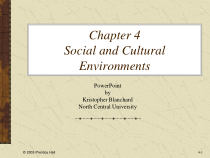 PPT
PPT
【文档说明】ch04SocialandCulturalEnvironments(全球营销,沃伦.pptx,共(31)页,322.758 KB,由精品优选上传
转载请保留链接:https://www.ichengzhen.cn/view-282786.html
以下为本文档部分文字说明:
Chapter4SocialandCulturalEnvironmentsPowerPointbyKristopherBlanchardNorthCentralUniversity©2005PrenticeHall4-1TaskofGlobalMarketersStudyandunder
standthecountryculturesinwhichtheywillbedoingbusinessIncorporatethisunderstandingintothemarketingplanningprocess©2005PrenticeHall
2Introduction“Itisnotjustspeakingacommonlanguage.Itissharingacultureandunderstandingfriendshipsinthesameway”JuanVillanonga–FormerChai
rmanofTelefonica©2005PrenticeHall3Society,Culture,andGlobalConsumerCultureCulture–Waysofliving,builtupbyagroupofhuma
nbeings,thataretransmittedfromonegenerationtoanotherCultureisactedoutinsocialinstitutionsCulturehasbothconsciousandunconscio
usvalues,ideasandattitudesCultureisbothmaterialandnonmaterial©2005PrenticeHall4Society,Culture,andGlobalConsumerCulture“Cultureisthecolle
ctiveprogrammingofthemindthatdistinguishesthemembersofonecategoryofpeoplefromthoseofanother.”-GeertHofstede©2005Prenti
ceHall5Society,Culture,andGlobalConsumerCultureGlobalconsumerculturesareemerging–Personswhosharemeaningfulsetsofconsumption-r
elatedsymbols–Popculture;coffeeculture;fast-foodculturePrimarytheproductofaninterconnectedworld©2005PrenticeHall6Attitudes,BeliefsandValuesAttitud
es-learnedtendencytorespondinaconsistentwaytoagivenobjectorentityBelief-anorganizedpatternofknowledgethatanindividualholdstobetrueabouttheworldVal
ue-enduringbelieforfeelingthataspecificmodeofconductispersonallyorsociallypreferabletoanothermodeofco
nduct©2005PrenticeHall7ReligionReligionisoneimportantsourceofsociety’sbeliefs,attitudes,andvalues.Theworld
’smajorreligionsinclude:Buddhism,Hinduism,Islam,Judaism,andChristianity.©2005PrenticeHall8Religion©2005PrenticeHall9AestheticsThesenseofwhati
sbeautifulandwhatisnotbeautifulWhatrepresentsgoodtasteasopposedtotastelessnessorevenobscenityVisual–embodiedinthecolororshapeofaproduct,label,orpack
ageStyles–variousdegreesofcomplexity,forexampleareperceiveddifferentlyaroundtheworld©2005PrenticeHall10DietaryPreferencesWouldyoueat…..–Reindeer(Fi
nland)–Rabbit(France)–Rice,soup,andgrilledfishforbreakfast(Japan)–Kimchi-Korea–Bloodsausage(Germany)©2005PrenticeHall11Langu
ageandCommunicationLinguisticCategoryLanguageExampleSyntaxEnglishhasrelativelyfixedwordorder;Russianh
asrelativelyfreewordorderSemanticsJapanesewordsconveynuancesoffeelingforwhichotherlanguageslackexactcorrelations;‘yes’and‘no’canb
einterpreteddifferentlythaninotherlanguages.PhonologyJapanesedoesnotdistinguishbetweenthesounds‘l’and‘r’;Englishand
Russianbothhave‘l’and‘r’sounds.MorphologyRussianisahighlyinflectedlanguage,withsixdifferentcaseendingsfornounsandadjectives;Englishahsfewerinflec
tions.©2005PrenticeHall12LanguageandCommunicationVerbalCuesNonverbalcuesorbodylanguage©2005PrenticeHall13Marketing’sImpactonCultureUniversalaspectso
ftheculturalenvironmentrepresentopportunitiestostandardizeelementsofamarketingprogramImprovedcommunicationshavecontributedto
aconvergenceoftastesandpreferencesinanumberofproductcategories©2005PrenticeHall14Marketing’sImpactonCultureMovementhas70,000membersin35countries“Slow
foodisabouttheideathatthingsshouldnottastethesameeverywhere.”©2005PrenticeHall15High-andLow-ContextCulturesHighContext–Informationresi
desincontext–Emphasisonbackground,basicvalues–Lessemphasisonlegalpaperwork–FocusonpersonalreputationSaudiArabia,JapanLowC
ontext–Messagesareexplicitandspecific–Wordscarryallinformation–Relianceonlegalpaperwork–Focusonnon-personaldocumentationofcredibilitySwi
tzerland,US,Germany©2005PrenticeHall16High-andLow-ContextCulturesFactor/DimensionHighContextLowContextLawyersLessImportantVeryImportantAperson’swor
dIshis/herbondNotreliable–getitinwritingResponsibilityforOrganizationalerrorTakenbyhighestlevelPushedtothelowestlevelSp
acePeoplebreatheoneachotherPrivatespacemaintainedTimePolychronicMonochronicCompetitiveBiddingInfrequentCommon
©2005PrenticeHall17Hofstede’sCulturalTypologyPowerDistanceIndividualism/CollectivismMasculinityUncertaintyAvoida
nceLong-termOrientation©2005PrenticeHall18Self-ReferenceCriterionandPerceptionUnconsciousreferencetoone’sownculturalvalues;crea
tesculturalmyopiaHowtoReduceCulturalMyopia:–Definetheproblemorgoalintermsofhomecountryculturaltraits–Definetheprobl
emintermsofhost-countryculturaltraits;makenovaluejudgments–IsolatetheSRCinfluenceandexamineit–Redefineth
eproblemwithouttheSRCinfluenceandsolve©2005PrenticeHall19DiffusionTheoryTheAdoptionProcessCharacteristicsofInno
vationsCategoriesofAdopters©2005PrenticeHall20MarketingImplicationsThetopicsinthischaptermustbeconsideredwhenformulatingaglobalmarketingplanE
nvironmentalSensitivityreflectstheextenttowhichproductsmustbeadaptedtotheculture-specificneedsofdiffe
rentnationalmarkets©2005PrenticeHall21EnvironmentalSensitivity©2005PrenticeHall22LookingAheadtoChapter5ThePolitica
l,Legal,andRegulatoryEnvironmentsofGlobalMarketing©2005PrenticeHall23SocialInstitutionsFamilyEducationReligionGovernmentBusin
essTheseinstitutionsfunctiontoreinforceculturalnormsReturn©2005PrenticeHall24MaterialandNonmaterialPhysical
componentsofculture–Objects–Artifacts•Clothing•Tools•Pictures•HomesSubjectiveorabstractculture–Religi
on–Perceptions–Attitudes–Beliefs–ValuesReturn©2005PrenticeHall25AestheticsandColorWhatdoyouassociatewithRed?–Active,hot,vibrant–WeddingsinsomeAsiancu
ltures–PoorlyreceivedinAfricancountriesWithwhite?–Purity,cleanliness–DeathinpartsofAsiaReturn©2005Prent
iceHall26PhonologyinactionColgateisaSpanishcommandthatmeans‘gohangyourself’TechnologyimplicationsforTextmessages–8282means‘hurryup’(Korea)–7
170means‘closefriend’(Korea)–45683968means‘ILoveYou’(Korea)Return©2005PrenticeHall27TheAdoptionProcessThementalstages
throughwhichanindividualpassesfromthetimeofhisorherfirstknowledgeofaninnovationtothetimeofproductadoptionorpurchase–Awareness–Interest–Evaluat
ion–Trial–AdoptionReturn©2005PrenticeHall28CharacteristicsofInnovationsInnovationissomethingnew,fivefactorsthata
ffecttherateatwhichinnovationsareadoptedinclude–Relativeadvantage–Compatibility–Complexity–Divisibility–CommunicabilityReturn©2005PrenticeHall
29CategoriesofAdoptersClassificationsofindividualswithinamarketonthebasisoftheirinnovativeness.Fivecategories–Innovators–EarlyAdopters–Earlym
ajority–Latemajority–Laggards©2005PrenticeHall30CategoriesofAdoptersReturn©2005PrenticeHall31
 辽公网安备 21102102000191号
辽公网安备 21102102000191号
 营业执照
营业执照